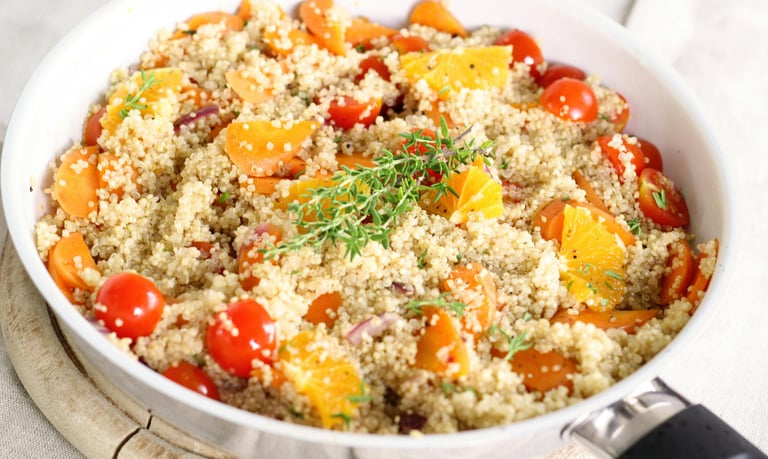How To Cook Quinoa: The Best Method for Fluffy Grains
FOODCOOKING


A well-cooked bowl of quinoa boasts a light, delicate, and slightly chewy consistency, making it the ideal foundation for grain bowls, salads, and elegant side dishes.
Quinoa has long transcended its superfood status to become a staple in high-end kitchens, health-conscious homes, and fine dining establishments alike. But while this protein-packed grain is celebrated for its nutritional prowess, many find it challenging to cook properly. Too much liquid? It turns into a mushy, uninspiring mess. Too little? It remains unpalatably crunchy. The key lies in mastering the right technique. If you've ever wondered how to cook quinoa so that it’s nice and fluffy, this guide will ensure you get perfect results every single time.
Why Cooking Quinoa Correctly Matters
Texture is everything. A well-cooked bowl of quinoa boasts a light, delicate, and slightly chewy consistency, making it the ideal foundation for grain bowls, salads, and elegant side dishes. But a misstep in preparation can lead to a clumpy, sticky disappointment. The texture directly influences its versatility, whether it's served warm with roasted vegetables or chilled in a citrusy Mediterranean salad.
Beyond texture, proper cooking is essential for removing bitterness from saponins, the natural coating that protects quinoa in the wild. If you've ever tasted a slightly soapy or unpleasantly bitter note in your dish, it's likely due to skipping a crucial first step: rinsing. Eliminating these saponins not only enhances flavor but also ensures a more refined, delicate taste that pairs effortlessly with a variety of ingredients.
The Secret to Perfectly Fluffy Quinoa
Achieving perfectly cooked quinoa is easier than you think, but it does require attention to detail. Here’s the foolproof method:
Rinse first
Before cooking, place your quinoa in a fine-mesh sieve and rinse it thoroughly under cold running water for at least 30 seconds. This step removes the bitter saponin coating, ensuring a clean, natural flavor.
Use the right ratio
Forget the generic 1:2 ratio often found in recipes. The best quinoa cooking ratio is 1 cup of quinoa to 1 ¾ cups of water or broth. This slight adjustment prevents excess moisture while allowing the grains to cook to perfection.
Simmer, don’t boil
Bring the liquid to a gentle boil over medium-high heat, then immediately reduce it to a low simmer. Cover the pot and let it cook undisturbed for about 15 minutes. Excessive heat or frequent stirring can disrupt the grains, resulting in a mushy texture.
Let it steam
Once the liquid is fully absorbed, remove the pot from heat, keep it covered, and let it sit for five minutes. This resting period allows the residual steam to finish the cooking process and enhances the fluffiness.
Fluff with a fork
Gently fluff the quinoa with a fork before serving. This step aerates the grains, separating them for that light and airy texture you’re aiming for.
Common quinoa mistakes to avoid
Even the most experienced cooks can fall into common pitfalls when preparing quinoa. Here’s what not to do:
Using too much water – Excess liquid results in a gummy, porridge-like texture rather than separate, tender grains.
Skipping the rinse – Without washing, quinoa retains its natural bitterness, which can overwhelm delicate dishes.
Stirring too much – Unlike risotto, quinoa does not benefit from constant stirring. Overmixing breaks the grains and creates an unpleasantly dense texture.
How to make quinoa more flavorful
While quinoa has a mild, slightly nutty flavor on its own, you can easily make quinoa taste better with a few strategic enhancements:
Cook in broth
Swap plain water for vegetable broth, just like we did in our favorite quinoa salad. Feel free to use chicken broth too. Either option infuses depth and richness into the grains.
Toast before cooking
For a deeper, nuttier flavor, toast the quinoa in a dry pan over medium heat for 3–5 minutes before adding liquid. This enhances its natural earthiness and adds a layer of complexity to your dish.
Infuse with aromatics
Introduce extra character by adding garlic cloves, bay leaves, or citrus zest to the cooking liquid. These subtle additions infuse each grain with an elegant, nuanced taste.
Perfect quinoa is light, fluffy, and never mushy. Whether it’s the star of a vibrant grain bowl or a refined side dish, properly cooked quinoa elevates any meal with its delicate texture and versatility. With the right technique and a few creative enhancements, it can easily become a staple in your kitchen, perfect for both everyday meals and party menus.
Disclaimer: The recipes and food recommendations in this article are for general inspiration and enjoyment. Since dietary preferences and restrictions vary, we recommend consulting with a nutritionist or dietitian if you have specific dietary concerns or health conditions. This article may contain affiliate links, meaning we may earn a small commission if you make a purchase through them. Please note that ingredient availability and cooking times may vary based on location and personal preferences.
